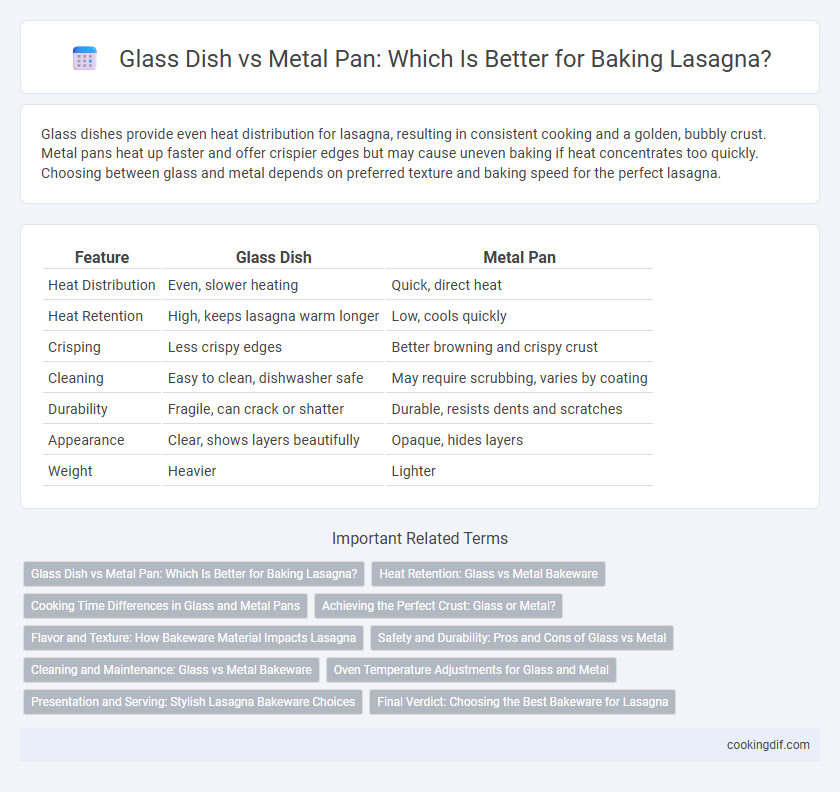Glass dishes provide even heat distribution for lasagna, resulting in consistent cooking and a golden, bubbly crust. Metal pans heat up faster and offer crispier edges but may cause uneven baking if heat concentrates too quickly. Choosing between glass and metal depends on preferred texture and baking speed for the perfect lasagna.
Table of Comparison
| Feature | Glass Dish | Metal Pan |
|---|---|---|
| Heat Distribution | Even, slower heating | Quick, direct heat |
| Heat Retention | High, keeps lasagna warm longer | Low, cools quickly |
| Crisping | Less crispy edges | Better browning and crispy crust |
| Cleaning | Easy to clean, dishwasher safe | May require scrubbing, varies by coating |
| Durability | Fragile, can crack or shatter | Durable, resists dents and scratches |
| Appearance | Clear, shows layers beautifully | Opaque, hides layers |
| Weight | Heavier | Lighter |
Glass Dish vs Metal Pan: Which Is Better for Baking Lasagna?
Glass dishes provide even heat distribution and retain heat well, ensuring lasagna cooks uniformly with a nicely browned top. Metal pans heat up quickly and offer superior heat conduction, resulting in crispier edges and a shorter baking time. Choosing between glass and metal depends on whether you prioritize consistent internal cooking or a crunchy, golden crust on your lasagna.
Heat Retention: Glass vs Metal Bakeware
Glass bakeware excels in heat retention, absorbing and distributing heat evenly, resulting in consistent cooking and better browning for lasagna. Metal pans heat up quickly but lose heat faster when removed from the oven, potentially affecting the final texture and temperature retention of the dish. Choosing glass ensures slow, even heat release, while metal offers faster cooking with less heat stability.
Cooking Time Differences in Glass and Metal Pans
Glass dishes generally require a longer cooking time than metal pans due to their slower heat conduction, which allows heat to penetrate more evenly but less quickly. Metal pans heat up rapidly and provide more direct heat to the edges of the lasagna, often resulting in faster cooking and crispier edges. Understanding these differences is essential for adjusting baking times to achieve optimal lasagna texture and doneness.
Achieving the Perfect Crust: Glass or Metal?
Glass dishes provide even heat distribution and retain heat longer, promoting a uniformly browned lasagna crust with a tender interior. Metal pans heat up faster and create a crisper, more intense crust, ideal for those who prefer a crunchy texture on top. Choosing glass or metal bakeware affects the crust's texture and color, so select based on whether you prioritize even cooking or a sharper, crispier crust.
Flavor and Texture: How Bakeware Material Impacts Lasagna
Glass dishes distribute heat evenly, promoting a consistent bake that enhances the lasagna's creamy texture and allows the flavors to meld smoothly. Metal pans conduct heat faster, creating a crispier, browned crust on the edges and top, intensifying the savory, caramelized flavors. Choosing glass results in a tender, uniformly cooked lasagna, while metal bakeware produces a contrast between a crunchy exterior and moist interior.
Safety and Durability: Pros and Cons of Glass vs Metal
Glass dishes for lasagna offer excellent heat retention and even cooking without reacting with acidic tomato sauces, providing a safer option for food integrity, though they are more prone to breaking or chipping. Metal pans, typically made of aluminum or stainless steel, heat up quickly and are highly durable, resisting dents and warping, but some may cause uneven cooking and react with acidic ingredients, potentially affecting taste and safety. Choosing between glass and metal bakeware depends on balancing the need for durability with safe, non-reactive cooking surfaces, considering that glass requires careful handling while metal excels in resilience.
Cleaning and Maintenance: Glass vs Metal Bakeware
Glass bakeware for lasagna offers non-porous surfaces that resist staining and odors, making cleaning easier with simple soaking and gentle scrubbing. Metal pans, while lightweight and excellent for heat conduction, often require seasoning or careful hand washing to prevent rust and maintain non-stick properties. Choosing glass reduces maintenance effort and extends bakeware longevity due to its durability and stain resistance.
Oven Temperature Adjustments for Glass and Metal
Glass bakeware retains heat longer and requires lowering the oven temperature by 25degF to prevent overcooking lasagna edges, while metal pans heat up quickly and promote even browning without temperature adjustments. Metal pans are ideal for achieving a crispier crust due to faster heat conduction, whereas glass dishes provide a gentler, more evenly distributed heat that suits longer baking times. Adjusting baking times is crucial when switching between glass and metal to ensure perfectly cooked layers and textures in lasagna.
Presentation and Serving: Stylish Lasagna Bakeware Choices
Glass dishes offer a clear view of lasagna layers, enhancing presentation with vibrant colors visible through the sides, creating an elegant serving experience. Metal pans provide a rustic, golden-brown crust that appeals visually and adds texture, ideal for a more traditional or hearty presentation. Selecting between glass and metal bakeware influences not only cooking performance but also the aesthetic appeal and ease of serving lasagna.
Final Verdict: Choosing the Best Bakeware for Lasagna
Glass dishes provide even heat distribution and retain heat longer, resulting in a well-cooked, evenly browned lasagna. Metal pans heat up faster, promote crispier edges, and excel at browning the crust, enhancing texture. For ultimate lasagna texture, choose glass bakeware for consistent cooking and metal pans for a crispier finish.
Glass dish vs Metal pan for bakeware Infographic

 cookingdif.com
cookingdif.com